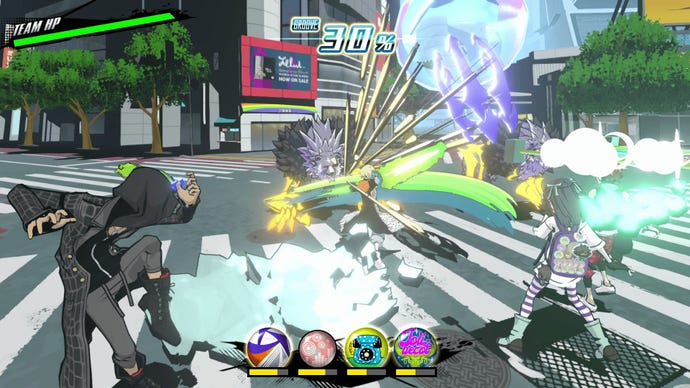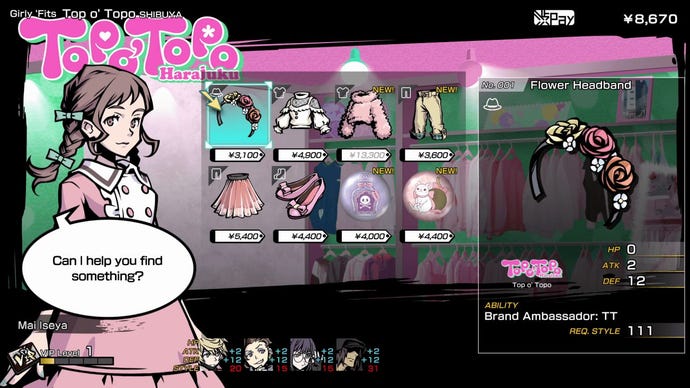How NEO: The World Ends With You captures the 15 year evolution of Shibuya, and is a better game for it
The game immerses you in one of the most iconic parts of Tokyo
NEO: The World Ends With You is out on PC today (via the Epic Games Store), and marks the grand return of a franchise that, despite a rabid fanbase and numerous re-releases, is only receiving its first sequel after 15 years. The original The World Ends With You impressed audiences on Nintendo DS as much for the game’s stylish Tokyo setting as it did for a unique battle system that saw players control multiple characters on multiple screens simultaneously. Yet what made this game really memorable was how it transformed the fashion and pop-cultural power of Shibuya into its own JRPG battle system. Your drip gave you strength, your armor made you a trendsetter, and the music and energy of the city were translated into a story about coming-of-age, self-worth and finding strength in yourself and your friends by embracing the things that make you unique.
Now, NEO: The World Ends With You has arrived, but this long-awaited sequel is far from a simple retread of what the first game did 15 years ago. Shibuya itself has changed a lot in the intervening years and it's fascinating to see how NEO's setting and its gameplay mechanics have evolved alongside it.
Making a sequel to a game so defined by its real-life setting is easier said than done. The World Ends With You has a good premise, in which the dead compete in the Reapers' Game, a competition to win the chance to return to life or ascend to a higher form. But a huge part of the appeal is the game’s accurate recreation of Shibuya at the time of its release, which now feels like a retro relic peppered with flip phones and edgy teens. In-game influencer The Prince is an approximation of the ubiquity and appeal of celebrities like GACKT who aren’t the same as the Japanese celebrities of today, and even the in-game band Def Märch were styled after the likes of Asian Kung-Fu Generation, The Gazette and The Blue Hearts.
The Shibuya of today is still a blend of art, fashion, and culture driven by the ideals of those born and raised on its streets, but while it remains a place where you can catch the birth of new musicians finding their voice or fashion trends soon to sweep the nation, it’s not the Shibuya that existed in the original game. Shibuya has evolved, and NEO: The World Ends With You couldn’t succeed through replication. The game had to evolve along with its environment, mechanically as well as aesthetically, if it wanted to represent its ever-changing city in flux.
One reason NEO needed to evolve its interpretation of Shibuya is obvious: many of the original game’s most memorable locales no longer exist today. Take the AMX store, for example. This was an in-game replacement for the flagship HMV megastore that once stood in Shibuya in the mid-2000s, yet closed shortly after the financial crash in 2010. Following its closure, Forever 21 first took over the empty store as a symbol of the growing popularity of foreign-produced fast fashion. Now it’s an IKEA.

MODI, the department store that stands tall on the same street as Tower Records, is another new shop replacing the old Marui City, while the PARCO store featured in the game only reopened in November 2019 after years of rebuilding and modernization work. Shibuya Stream was a newbuild that opened in 2018, and even Shibuya 104, this game’s take on Shibuya 109, needed a facelift for the sequel: the building replaced its old logo in 2019.
Shibuya’s melting pot of fashion and popular culture results in a city that exists in a constant state of flux, always evolving with the interests and trends of the people within it. You can’t replicate Shibuya without also capturing its penchant nature to evolve with the times; you need to leave behind the original game’s inspirations from designers like Rei Kawakubo and Yohji Yamamoto and gyaru fashion to portray the city as it exists today, even if it results in beloved in-game fashion brands being replaced. Gameplay, too, can't stick with routine because the tastes of players and the hardware available to developers has changed drastically.

Even the rules of the Reapers' Game have evolved over the past 15 years. Rather than playing in pairs for your survival, the Game in NEO is a team-based, points-driven affair. This offers our characters a little more time to explore Shibuya and what it has to offer, and even allows teams to ignore the game for a day if they have points or other plans. The increased number of players also allows more interaction with people from the varied subcultures that make up the city. Whereas before our limited interaction came from imprinting and influencing people's minds without ever conversing directly, players on other teams represent the fashion and ideas that define Shibuya as a living, breathing (and ever-changing) cultural hub.
Back in 2019, I was lucky to have the opportunity to live among the busy streets of Tokyo, and I spent a lot of that time ignoring my responsibilities to visit Shibuya. To me, Shibuya was this place where I could discover a rock band or small idol group on the cusp of stardom performing in a small livehouse for 50 fans, or see a major concert at Tsutaya O-West, O-East or the newly-opened Shibuya Stream Hall inside the newbuild skyscraper and retail complex. There was always something new to discover. It was also a place of self-discovery, and a safe space where I learned to express and understand myself through fashion. The more time I spent in Shibuya the more I experimented, and it was always a thrill to wander off the beaten track and find independent fashion brands innovating with new styles, just as much as it was to gander at the offerings in stores run by established brands like BAPE, X-Girl and Candy Stripper.
"NEO: The World Ends With You allows players to experience Tokyo subcultures and meet the people who make the city their home."
It was the fun I had with friends and the chance encounters with like-minded people, more than anything, that made Shibuya so exciting. Many of the people running these clothes stores, particularly independent ones, possess a shared love for fashion's expressive qualities beyond its existence as a mere article of clothing. The passionate fans of musicians are desperate to share that love with others. Those chance interactions remain the most memorable from my time in Japan, and the ones I miss the most. I doubt I'll ever forget the friends I made when I went to a concert in the basement of Tower Records for a pre-major debut idol group, or the time I accidentally stumbled upon a few people doing a fashion shoot in a side street in Harajuku.
If the original The World Ends With You did a good job of capturing Shibuya’s identity as a cultural beacon for Tokyo and the world in the mid-2000s, NEO: The World Ends With You allows players to experience Tokyo subcultures and meet the people who make the city their home. It adds more characters to interact with within the UG (the Underground, the parallel world where the Reapers' Game takes place), which means players can engage with Shibuya as a place, not as a mere aesthetic, and the jump from 2D in the original to 3D in NEO further places the player right at the heart of the bustling metropolis. By representing Shibuya in this new and exciting manner, it makes this familiar city feel new again too.

There’s a storyline in the early hours of NEO: The World Ends With You which encapsulates this experience. On one of the days where you're searching for a Golden Pig Noise (Noise being the main enemies in the series), you need to distract the members of another team. To do so, you need to find out what these people are passionate about and share that passion with them so they'll indulge their interests rather than focusing on the mission at hand. As I distracted one group of fans with news of an upcoming performance for their beloved Peroxidols, I couldn’t help but think of the times I skipped university lectures to do just that for a cheki (Polaroid) with my favorite BiSH member.
Through events like this, and a greater interest in placing the player and your team on ground zero in the streets of Shibuya, NEO: The World Ends With You recognizes that nothing stays the same. Gaming hardware evolves, people evolve, and yes, cities evolve too. Even in the six short months I lived in Tokyo, I watched Shibuya transform almost beyond recognition. I watched the rebrand of Shibuya 109’s logo in real-time, and I watched stores open and close on a near-weekly basis.

These changes have only grown more stark since I left because of the impact of Covid. I’ve watched from afar as headlines announced the closure of many of my favorite livehouses and even an independent cinema I loved to visit that had stood for decades. The makeup of this iconic city has transformed again as many of its cultural landmarks disappear.
A lot can change in 15 years, and NEO: The World Ends With You understands that. This is Shibuya, but not as you remember it from the first game. And that’s exactly as it should be.


